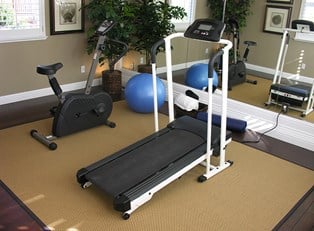There are lots of benefits to having your own home gym, but they come with a great deal of responsibility. It's crucial to ensure that your workout space and equipment are safe to use. While this process will take some work and diligence on your part, ensuring safety in your gym is not a very complicated process—many suggestions will sound like common sense to most people. However, if you’re just starting out, it is valuable to address some of the basics of safety. Here are some tips for maintaining a safe workout environment in your own home gym.
Read the instruction manuals for all your equipment.
Even though operating something as simple as a treadmill or exercise bike may seem like a no-brainer, swallow your pride and read the manual anyways. If you already have a familiarity with exercise equipment, you may think you can find your way through the setup and use process, but cutting corners and taking risks is how you get injured in your home gym. In addition to reading the instructions, look for videos online that demonstrate people setting up and using the equipment, if possible.
Keep your home gym clean.
Keeping your home gym free of clutter is an important step to minimizing your risk of injury. It can be quite tempting to leave equipment like dumbbells lying around, but there’s no better way to stub a toe or trip than this. Additionally, be sure to keep your equipment clean and germ-free by wiping it down after every use. Be sure to clean surfaces that involve a great deal of physical contact, such as handles and seats of exercise bikes and buttons on treadmills. This is especially important if other people besides yourself will be using your space to work out.
Have a spotter when necessary.
One of the benefits of having a own home gym is not dealing with crowds of other people in public workout spaces. However, just because you’re looking for peace and quiet when exercising doesn’t mean you should always do it alone. Chances are you won’t need any assistance operating the treadmill or similar equipment, but if you’re going to be lifting weights, make sure to have a workout partner around to spot you.
Don’t buy cheap equipment.
You may be tempted to save a couple bucks and go with cheap exercise equipment, but in the long run this only jeopardizes your safety. While poorly made exercise bikes or weight benches may start out working well, they’re likely to break down faster and in more dangerous ways than high-quality equipment. There’s no surefire way to tell if a piece of equipment is worth the money you’ll spend on it, but reading reviews from both exercise experts and average users is a good place to start.
Inspect your equipment regularly.
Even the best workout equipment needs safety inspections from time to time. These inspections should be done monthly, if possible. During these inspections, look for any loose screws or bolts and be sure watch out for breakages in any moving equipment parts, such as hinges, cables, or pulleys. Additionally, if you have weight lifting equipment be sure to inspect the structural integrity of your bars and racks.
Keep your kids safe.
If you have children, they’ll probably be very interested in exploring your home gym. However, letting them use equipment unsupervised can lead to injuries. If possible, keep a lock on the door to prevent them from entering when you’re not around, and be sure to instruct them well on how to use the equipment if they will be working out with you.



